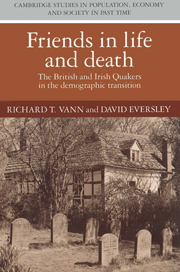Book contents
- Frontmatter
- Contents
- List of figures
- List of tables
- Preface
- Introduction
- 1 The quality of the sources
- 2 Characteristics of the sample
- 3 Marriage according to Truth
- 4 The fruitfulness of the faithful
- 5 The quality and quantity of life
- Conclusion
- Bibliography
- Index
- Cambridge Studies in Population, Economy and Society in Past Time
3 - Marriage according to Truth
Published online by Cambridge University Press: 23 September 2009
- Frontmatter
- Contents
- List of figures
- List of tables
- Preface
- Introduction
- 1 The quality of the sources
- 2 Characteristics of the sample
- 3 Marriage according to Truth
- 4 The fruitfulness of the faithful
- 5 The quality and quantity of life
- Conclusion
- Bibliography
- Index
- Cambridge Studies in Population, Economy and Society in Past Time
Summary
Of all the activities that demographers study, marriage is the most embedded in culture. It is therefore the most variable among human communities. Just before World War II over half the women aged over 29 in Ireland, Sweden, and Finland had not yet married and more than a quarter of them were destined never to do so. At the same time in Korea, 98 percent of teen-aged women were already brides, and only 1 in 1,000 failed to marry before the age of 50.
To the historical demographer, especially in the last few years, patterns of marriage behavior or nuptiality have come to be of absorbing interest. For English society as a whole, fertility within marriage does not offer much change to explain; it seems to have stayed pretty much the same from the sixteenth century to around 1825. Mortality did change; but some of the change seems to lie more in the history of microbes, in that variations in their virulence, rather than in what humans could do about them, apparently account for some of the difference in death rates. Nuptiality is thus the arena where there is significant change resulting entirely from human agency.
Furthermore, changes in nuptiality are now believed to be the key to the great increase in the population of England after 1750.
- Type
- Chapter
- Information
- Friends in Life and DeathBritish and Irish Quakers in the Demographic Transition, pp. 80 - 128Publisher: Cambridge University PressPrint publication year: 1992

